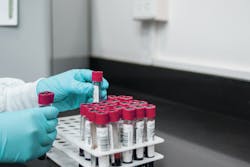Multiplex detection, sequencing and assessment of anti-viral immunization for SARS-CoV-2
Creating severe challenges, an unprecedented worldwide spread of SARS-CoV-2 impacted healthcare facilities, medical infrastructure, and developments in precision medicine. The ongoing COVID-19 pandemic has had devastating effects on populations, social structures, and economic growth for many nations. These are further impacted by the increasing extent of global connectivity and geographical mobility, which expedite infection spread at an uncontrollable pace.
Advances in diagnostic tools, treatment strategies, vaccine developments and logistical rollouts all play a pivotal role in mitigating the control and spread of SARS-CoV-2. Effective control and containment of this pathogen requires reliable diagnostic assays and potent therapeutic agents that interlink with molecular techniques, as well as accelerated vaccine development efforts. Advanced methodologies can be used in tracking and monitoring SARS-CoV-2 genomic sequences and viral evolution and spread around the world, while measuring the efficacy of vaccines throughout the course of clinical trials.
Multiplex SARS-CoV-2 detection
Recognized as the gold standard, polymerase chain reaction (PCR) is one of the most powerful technologies in molecular biology.1 Using PCR, specific sequences can be copied, or “amplified,” many thousand- to million-fold using sequence-specific oligonucleotides. Current front-line PCR testing only determines the presence of the virus with most commercial assays identifying SARS-CoV-2 and using a confirmatory method. However, as the spread continues, molecular techniques have been criticized for not identifying the genetic sequence of the virus or any information about the patient’s immune response.2
In addition, many diagnostic assays currently available and in development do not provide clarity in identifying patients who have co-infections with symptoms similar to COVID-19. This, in turn, provides a need for a multiplex approach for situations, in which testing only for SARS-CoV-2 isn’t enough. As SARS-CoV-2 affects the respiratory tract, it’s vital that a multiplex molecular-based assay is used to not only identify SARS-CoV-2, but differentiate it from other viral respiratory pathogens, such as MERS, Influenza A / B and RSV.
SARS-CoV-2: Sequencing for Mutations
Coronaviruses are a group of related RNA viruses known to cause respiratory tract infections in humans and other animals. Although all viruses mutate while replicating and infecting host cells, RNA viruses are particularly unstable; meaning, they are more prone to mutation during replication.
When viruses produce copies of their genomes inside host cells, mutations – changes in their genome sequence – can occur. Mutations can affect the way viruses infect cells and replicate within them. They can lead to subtle changes in viral proteins, which can prevent existing antibodies in the immune system from recognizing the virus. Mutations can also reduce the efficiency of antiviral treatments. It’s important to identify and catalog mutations, to better understand how viruses – such as the SARS-CoV-2 coronavirus that causes COVID-19 – spread and evolve over time.
The majority of viral mutations are minor and have no impact on the virus or the disease it causes. However, multiple mutations can lead to a new variant of a virus emerging, and sometimes, it is possible these new variants are more transmissible or deadly, as they can better evade the immune system. Globally, this has raised concerns about the efficacy of current vaccine rollouts and halted clinical trials currently underway for SARS-CoV-2. The emergence of these variants has created concerns that the vaccines authorized for COVID-19 may not be the way out of the pandemic that the world had hoped for. Fortunately, next-generation vaccines are coming through the pipeline, which have been designed with potential COVID-19 mutations and variants specifically in mind.
Circulating globally, there are now a few concerning mutations: the B.1.1.7 and the B.1.525 lineages in the United Kingdom, the B.1.351 lineage in South Africa, the B.1.1.28 lineage in Brazil, and many more. Some of these emerging variants are thought to be more transmissible, cause more severe disease and/or reduce efficacy of treatments and vaccines. Furthermore, variants may impact the performance of current diagnostic approaches.
Of particular interest is a double deletion at position 69-70 of the spike protein gene (69-70del), observed in the B.1.1.7 and B.1.525 variants, which has been found to affect the performance of some diagnostic PCR assays that use an S gene target (S gene dropout).3,4
SARS-CoV-2, like other known SARS-CoV and SARS-related coronaviruses, encodes several smaller open reading frames (ORFs) such as ORF1ab, ORF3a, ORF6, ORF7a, ORF7b, ORF8 and ORF10. These ORFs are predicted to encode for the replicase polyprotein, the spike (S) glycoprotein, envelope (E), membrane (M), nucleocapsid (N) proteins, accessory proteins, and other non-structural proteins (NSP).5,6,7
Virus sequencing has been widely adapted to confirm individuals with positive cases of SARS-CoV-2 to distinguish which variant that individual has been exposed to. Efforts across the globe are underway to confirm whether any of these mutations are contributing to increased transmission of infection. However, the B.1.1.7 and the B.1.525 lineages in the United Kingdom, the B.1.351 lineage in South Africa and the B.1.1.28 lineage in Brazil are the most concerning. Most of the attention is on mutations in the gene that encodes the spike protein, which is associated with viral entry into cells, because this is replicated in therapeutic agents and vaccine developments currently in progress.
Multiplex SARS-CoV-2 serology is a tool to assess anti-viral immunization.
Rapid and accurate antibody testing on a large scale is vital to addressing some of the challenges presented by the SARS-CoV-2 pandemic. It plays an important role in research at the precision-medicine level and in surveillance strategies.
Serology tests measure the presence of antibodies (Abs) in the blood that occur when the body is responding to a specific infection – in this case, SARS-CoV-2 – which causes individuals to be infected with COVID-19. Antibodies to COVID-19 are produced over days to weeks after infection with the virus. The presence of antibodies indicates that a person was infected with the SARS-CoV-2 virus, irrespective of whether the individual had severe or mild disease, or even asymptomatic infection.
The use of SARS-CoV-2 serology testing has been challenging for a variety of reasons, such as the realization that the humoral immune response to the natural infection was very variable between individuals, was not systematically correlated with the cellular immune response governing the long-term memory response and varied widely over time, with specific anti-viral antibodies waning rapidly after recovery.8,9,10
Establishing a universal serology assay, able to detect the SARS-CoV-2 antibodies in every subject exposed to the virus, therefore, requires exquisite sensitivity. By increasing the number of antigenic targets in a single test, the chances of detecting at least one of the targets at a significant level is one of the best ways to increase the clinical sensitivity of specific antibody detection. It can also be a useful indicator of the time of infection, based on the respective kinetic of the various Ab species.
With the massive vaccination effort in progress globally, it is also important to identify people with pre-existing SARS-CoV-2 antibodies (that would potentially be eligible to a single vaccinal injection), and to study the various antibody species after vaccination to potentially determine a protective Ab level. Obviously, the antigenic component of the vaccine will define immunological diversity. It is expected, that taking into account the contribution of each Ab fraction, rather than relying on a single one, may reflect more accurately the immune status of an individual. Also, with the likely migration from intramuscular to nasal vaccination, salivary immunological profiling will become increasingly dominant.10
Widely used by precision medicine, antibody testing provides benefits to validate the effectiveness of vaccine trials. When there is little or no access to molecular testing, serology tests provide a means to quickly triage suspected cases of COVID-19, enabling appropriate case management, and guiding public health measures, such as quarantine or self-isolation. It is recognized that conventional serological tests have a high-throughput advantage that can complement PCR molecular testing. Antibody detection combined with RT-PCR expands the detection window of SARS-CoV-2 infection and minimizes false negative results from RT-PCR testing. Widely noted for effectively discriminating vaccinated individuals from those who have been naturally infected, it can also be used to identify disease severity, enabling calculation of previse rates of infection and case fatality rates.
Vaccine efficacy itself is very carefully determined during clinical trials, with emphasis being placed on the amount of neutralizing Abs vs the total Ab response. At present, anti-S antibodies have been shown to be closely correlated with the anti-RBD neutralizing antibodies; however, little is known about the contribution of other Ab species to the total neutralization power of the immune response.11,12 A multiplex approach should, therefore, be of interest to vaccine developers, because it will help refine their assessment of their product’s efficacy at various time frames post injection.
References
- Wee SK, Paramalingam SS, Yap EPH. Rapid direct nucleic acid amplification test without RNA Extraction for SARS-CoV-2 using a portable PCR thermocycler. Genes. 2020; 11 (6): 664 doi: 10.3390/genes11060664.
- Peiris JS. Coronavirus as a possible cause of severe acute respiratory syndrome. Lancet. 2003;361:1319-1325. doi: 10.1016/s0140-6736(03)13077-2.
- Korber B, Fischer WM, Gnanakaran S, Yoon H, Theiler J, Abfalterer W, Hengartner N, Giorgi EE, Bhattacharya T, and Foley B. (2020). Tracking changes in SARS-CoV-2 spike: evidence that D614G increases infectivity of the COVID-19 virus. Cell 182, 812–827. e819. doi: 10.1016/j.cell.2020.06.043.
- Lan J, Ge J, Yu J, Shan S, Zhou H, Fan S, Zhang Q, Shi X, Wang Q., Zhang L, et al. (2020). Structure of the SARS-CoV-2 spike receptor-binding domain bound to the ACE2 receptor. Nature. 581, 215–220. doi: 10.1038/s41586-020-2180-5.
- Walls AC, et al. Structure, function, and antigenicity of the SARS-CoV-2 spike glycoprotein. Cell. 180, 1–12 (2020). Walls, AC. et al. Structure, function, and antigenicity of the SARS-CoV-2 spike glycoprotein. Cell 180, 1–12 (2020). doi: 10.1016/j.cell.2020.02.058.
- Ahmed SF, Quadeer A A, McKay MR. Preliminary identification of potential vaccine targets for the COVID-19 coronavirus (SARS-CoV-2) based on SARS-CoV immunological studies. Viruses. 12(3), 254 (2020). doi: 10.3390/v12030254.
- Phan T. Genetic diversity and evolution of SARS-CoV-2. Infect. Genet. Evol. 81, 104260 (2020). doi: 10.1016/j.meegid.2020.104260.
- Liu W, Fontanet A, Zhang PH, Zhan L, Xin ZT, Baril L, et al. Two-year prospective study of the humoral immune response of patients with severe acute respiratory syndrome. J Infect Dis (2006) 193(6):792–5. doi: 10.1086/500469.
- Gaebler C, Nussenzweig MC. All eyes on a hurdle race for a SARS-CoV-2 vaccine. Nature (2020) 586(7830):501–2. doi: 10.1038/d41586-020-02926-w.
- Ng K, Faulkner N, Cornish G, Rosa A, Earl C, Wrobel A, et al. Pre-existing and de novo humoral immunity to SARS-CoV-2 in humans. bioRxiv (2020). 2020.05.14.095414. doi: 10.1101/2020.05.14.095414
- Wong SK, Li W, Moore MJ, Choe H, Farzan MA. 193-amino acid fragment of the SARS coronavirus S protein efficiently binds angiotensin-converting enzyme 2. J Biol Chem. 2004; 279: 3197-3201.
- Tai W, He L, Zhang X et al. Characterization of the receptor-binding domain (RBD) of 2019 novel coronavirus: implication for development of RBD protein as a viral attachment inhibitor and vaccine. Cell Mol Immunol. 2020; 17: 613-620. doi: 10.1038/s41423-020-0400-4.
About the Author

Martin Conway, BSc
Martin Conway, BSc, serves as Marketing Team Lead for Chemistry, Immunoassay, Molecular and Point of Care Analyzer at Randox Laboratories.
